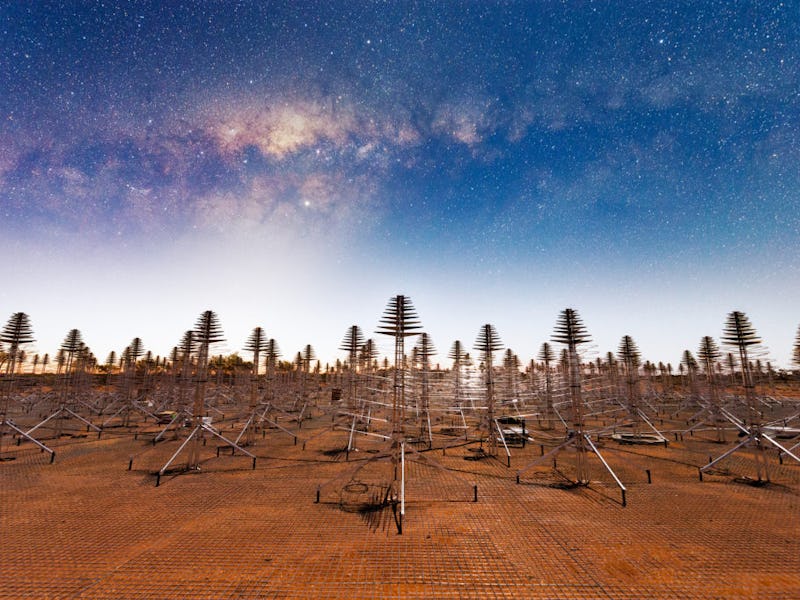Astronomers just completed the most rigorous hunt for aliens yet — here's what they found
"We have to keep looking."

Are we alone in the universe?
Astronomers have been trying to answer that question for centuries, searching for signs of life in the vast cosmos.
Now, using a wide-field radio telescope in Australia, a team of scientists announced the completion of the broadest and most detailed search for alien civilizations yet. The telescope scanned 10 million star systems for signs of intelligent life, finding little evidence of extraterrestrial life.
But there are good reasons to believe humans' cosmic kindred are indeed out there, somewhere. Why? Because of the very nature of the universe itself, the scientists behind the survey say.
The results were detailed in a study published Tuesday in the Publications of the Astronomical Society of Australia.
The antennas of the Murchison Widefield Array (MWA) radio telescope in Western Australia were used to scan the skies for signs of alien life.
Located in Western Australia, the Murchison Widefield Array (MWA) is a low frequency radio telescope that uses its antennas to detect radio waves from the skies. For this study, the team of astronomers pointed the telescope at a patch of the sky around the Vela constellation which contains at least 10 million stars.
Due to its wide array, the telescope was able to search for extraterrestrial life hundreds of times more broadly than any other previous attempt.
“The MWA is a unique telescope, with an extraordinarily wide field-of-view that allows us to observe millions of stars simultaneously,” Chenoa Tremblay, a researcher at the Curtin University node of the International Centre for Radio Astronomy Research (ICRAR) and lead author of the new study, said in a statement. "We observed the sky around the constellation of Vela for 17 hours, looking more than 100 times broader and deeper than ever before."
The telescope was searching for powerful radio emissions at frequencies that are similar to FM radio transmissions. These emissions are known as 'technosignatures.'
Unfortunately, the search came up empty.
The researchers were not surprised by the results, however, because, well, the universe is rather big.
"Even though this was a really big study, the amount of space we looked at was the equivalent of trying to find something in the Earth’s oceans, but only searching a volume of water equivalent to a large backyard swimming pool," Steven Tingay, a professor at Curtin University, and co-author of the study, said in a statement.
How do we look for aliens?
Assuming that there is extraterrestrial life in the universe, scientists are not sure what that alien life would look like. So they search for it using different techniques.
Orbiting space telescopes hunt for signs of even the smallest hint of life in planets in our Solar System and beyond, looking for clues of the biosignatures that indicate possible habitability.
This kind of survey is a little different: By searching for radio emissions on different planets, the scientists not only assume aliens must exist, but that they are an advanced civilization that utilizes technology the same way that we do on Earth.
This is where it gets slightly more complex. The known universe is 13.8 billion years old, while Earth itself formed a mere 3.5 billion years ago. Humans have been around for just 200,000 years, and modern civilization developed around 6,000 years ago.
Based on that timeline, it takes billions of years for a civilization to develop on a planet.
As a result, the chances of the human race existing at the same time another civilization has also developed in a similar way on another planet in the cosmos are pretty small.
But astronomers are not giving up anytime soon, and the search does get easier the more advanced our technology becomes.
“Although there is a long way to go in the search for extraterrestrial intelligence, telescopes such as the MWA will continue to push the limits — we have to keep looking," Tingay said.
Abstract: Following the results of our previous low-frequency searches for extraterrestrial intelligence (SETI) using the Murchison Widefield Array (MWA), directed towards the Galactic Centre and the Orion Molecular Cloud (Galactic Anticentre), we report a new large-scale survey towards the Vela region with the lowest upper limits thus far obtained with the MWA. Using the MWA in the frequency range 98–128 MHz over a 17-h period, a field centred on the Vela Supernova Remnant was observed with a frequency resolution of 10 kHz. Within this field, there are six known exoplanets. At the positions of these exoplanets, we searched for narrow-band signals consistent with radio transmissions from intelligent civilisations. No unknown signals were found with a 5detection threshold. In total, across this work plus our two previous surveys, we have now examined 75 known exoplanets at low frequencies. In addition to the known exoplanets, we have included in our analysis the calculation of the Effective Isotropic Radiated Power (EIRP) upper limits towards over 10 million stellar sources in the Vela field with known distances from Gaia (assuming a 10-kHz transmission bandwidth). Using the methods of Wright, Kanodia, & Lubar (2018) to describe an eight-dimensional parameter space for SETI searches, our survey achieves the largest search fraction yet, two orders of magnitude higher than the previous highest (our MWA Galactic Anticentre survey), reaching a search fraction of . We also compare our results to previous SETI programs in the context of the —Transmitter Rate plane. Our results clearly continue to demonstrate that SETI has a long way to go. But, encouragingly, the MWA SETI surveys also demonstrate that large-scale SETI surveys, in particular for telescopes with a large field-of-view, can be performed commensally with observations designed primarily for astrophysical purposes.